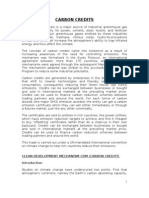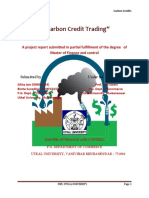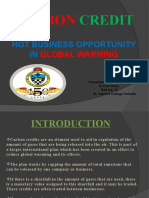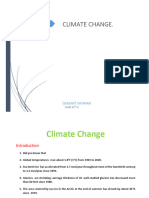Carbon Credits Are A Key Component of National and International Attempts To Mitigate The Growth in Concentrations of Greenhouse Gases
Carbon Credits Are A Key Component of National and International Attempts To Mitigate The Growth in Concentrations of Greenhouse Gases
Uploaded by
Tushar MishraCopyright:
Available Formats
Carbon Credits Are A Key Component of National and International Attempts To Mitigate The Growth in Concentrations of Greenhouse Gases
Carbon Credits Are A Key Component of National and International Attempts To Mitigate The Growth in Concentrations of Greenhouse Gases
Uploaded by
Tushar MishraOriginal Title
Copyright
Available Formats
Share this document
Did you find this document useful?
Is this content inappropriate?
Copyright:
Available Formats
Carbon Credits Are A Key Component of National and International Attempts To Mitigate The Growth in Concentrations of Greenhouse Gases
Carbon Credits Are A Key Component of National and International Attempts To Mitigate The Growth in Concentrations of Greenhouse Gases
Uploaded by
Tushar MishraCopyright:
Available Formats
Carbon credits are a key component of national and international attempts to mitigate the
growth in concentrations of greenhouse gases (GHGs). One carbon credit is equal to one ton of
carbon dioxide, or in some markets, carbon dioxide equivalent gases. Carbon trading is an
application of an emissions trading approach. Greenhouse gas emissions are capped and then
markets are used to allocate the emissions among the group of regulated sources. The goal is to
allow market mechanisms to drive industrial and commercial processes in the direction of low
emissions or less carbon intensive approaches than those used when there is no cost to emitting
carbon dioxide and other GHGs into the atmosphere. Since GHG mitigation projects generate
credits, this approach can be used to finance carbon reduction schemes between trading partners
and around the world.
There are also many companies that sell carbon credits to commercial and individual customers
who are interested in lowering their carbon footprint on a voluntary basis. These carbon
offsetters purchase the credits from an investment fund or a carbon development company that
has aggregated the credits from individual projects. The quality of the credits is based in part on
the validation process and sophistication of the fund or development company that acted as the
sponsor to the carbon project. This is reflected in their price; voluntary units typically have less
value than the units sold through the rigorously-validated Clean Development Mechanism
Burning of fossil fuels is a major source of industrial greenhouse gas emissions, especially for
power, cement, steel, textile, fertilizer and many other industries which rely on fossil fuels (coal,
electricity derived from coal, natural gas and oil). The major greenhouse gases emitted by these
industries are carbon dioxide, methane, nitrous oxide, hydrofluorocarbons (HFCs), etc, all of
which increase the atmosphere's ability to trap infrared energy and thus affect the climate.
The concept of carbon credits came into existence as a result of increasing awareness of the need
for controlling emissions. The IPCC (Intergovernmental Panel on Climate Change) has
observed[2] that:
Policies that provide a real or implicit price of carbon could create incentives for producers and
consumers to significantly invest in low-GHG products, technologies and processes. Such policies could
include economic instruments, government funding and regulation,
while noting that a tradable permit system is one of the policy instruments that has been shown
to be environmentally effective in the industrial sector, as long as there are reasonable levels of
predictability over the initial allocation mechanism and long-term price.
The mechanism was formalized in the Kyoto Protocol, an international agreement between more
than 170 countries, and the market mechanisms were agreed through the subsequent Marrakesh
Accords. The mechanism adopted was similar to the successful US Acid Rain Program to reduce
some industrial pollutants.
You might also like
- Carbon Credits - ProcedureDocument12 pagesCarbon Credits - Procedurehandfingure100% (5)
- Carbon Pricing For A Sustainable Future: (Critical Review)Document14 pagesCarbon Pricing For A Sustainable Future: (Critical Review)vikrant vardhan100% (1)
- Additional Benefit of Carbon Credit To Solar Projects:: BackgroundDocument2 pagesAdditional Benefit of Carbon Credit To Solar Projects:: BackgroundGaurav KumarNo ratings yet
- Carbon CreditsDocument3 pagesCarbon Creditsmithilesh_singhNo ratings yet
- Unfiled NotesDocument355 pagesUnfiled NotesrameshrajkotNo ratings yet
- 3 - Carbon CreditDocument7 pages3 - Carbon CreditRahul DuttaNo ratings yet
- "Carbon Credits": Assignment OnDocument16 pages"Carbon Credits": Assignment OnPranav Indulkar100% (1)
- Presentation 1Document9 pagesPresentation 1ধ্রুবজ্যোতি গোস্বামীNo ratings yet
- Home Finance Anand Wadadekar::: Carbon Credits byDocument4 pagesHome Finance Anand Wadadekar::: Carbon Credits byMark AmigoNo ratings yet
- Carbon CreditDocument2 pagesCarbon CreditSaba GheniNo ratings yet
- Background: Carbon Credits Are A Key Component of National and InternationalDocument6 pagesBackground: Carbon Credits Are A Key Component of National and Internationalkishorepatil8887No ratings yet
- Carbon CreditDocument13 pagesCarbon Creditmayank0999No ratings yet
- Topic - Carbon Footprint: Environmental Science ProjectDocument34 pagesTopic - Carbon Footprint: Environmental Science ProjectthecoolestguyjalajkNo ratings yet
- Carbon Credit and TradingDocument4 pagesCarbon Credit and TradingMohit NarulaNo ratings yet
- Carbon CreditDocument5 pagesCarbon CreditArun KumarNo ratings yet
- Carbon CreditDocument33 pagesCarbon CreditRobert RamirezNo ratings yet
- Carbon Trading SynopsisDocument28 pagesCarbon Trading SynopsisSumeet KaurNo ratings yet
- Carbon FootprintsDocument3 pagesCarbon Footprintsnikhilramane100% (1)
- Carbon Footprint in DC Draft v0-1Document15 pagesCarbon Footprint in DC Draft v0-1Roopesh KumarNo ratings yet
- Carbon Pricing NotesDocument12 pagesCarbon Pricing NotesGasser ElfahamNo ratings yet
- Environmental Groups Law of Demand: Creating Real Carbon CreditsDocument5 pagesEnvironmental Groups Law of Demand: Creating Real Carbon CreditsqistinahakimNo ratings yet
- Carbon CreditsfinalDocument14 pagesCarbon CreditsfinalHarsh N. DhruvaNo ratings yet
- A Blockchain Based Carbon Credit EcosystemDocument10 pagesA Blockchain Based Carbon Credit EcosystemHua Hidari Yang100% (1)
- Carbon CreditDocument12 pagesCarbon CreditA.K.M.Shadman 2013502 0 42No ratings yet
- Carbon Trade MarketDocument8 pagesCarbon Trade MarketNidhi BothraNo ratings yet
- Carbon Finance DhruvDocument72 pagesCarbon Finance Dhruvdhruv nijhawanNo ratings yet
- Carbon Markets Glossary of TermsDocument6 pagesCarbon Markets Glossary of TermsGreyce MaasNo ratings yet
- General CF and CDM Jan 2011Document25 pagesGeneral CF and CDM Jan 2011energymahesh2No ratings yet
- Carbon CreditDocument24 pagesCarbon CreditmmjmmjNo ratings yet
- CO2 TARIFFS DocumentDocument10 pagesCO2 TARIFFS DocumentMarcela AtehortuaNo ratings yet
- Carbon PricingDocument15 pagesCarbon PricingSIDDHARTH DASHNo ratings yet
- RussiaDocument8 pagesRussiaSameen Fakhar QureshiNo ratings yet
- 4.2 C Carbon - OffsetDocument24 pages4.2 C Carbon - OffsetShruti LakhanNo ratings yet
- Term PaperDocument61 pagesTerm PaperParasNo ratings yet
- Carbon CreditDocument4 pagesCarbon CreditrenroseloraNo ratings yet
- 03pa JS 4 1 PDFDocument6 pages03pa JS 4 1 PDFMarcelo Varejão CasarinNo ratings yet
- Carbon Credit TradingDocument6 pagesCarbon Credit Tradinganon_611702305100% (1)
- Carbon Credit BussinessDocument2 pagesCarbon Credit BussinessVishal IyerNo ratings yet
- Offsets Disclosures in Climate Risk Disclosure RuleDocument7 pagesOffsets Disclosures in Climate Risk Disclosure RuleIvica KelamNo ratings yet
- Carbon OffsetDocument12 pagesCarbon OffsetSoumya Satyakanta Sethi100% (1)
- Carbon White PaperDocument23 pagesCarbon White PaperLeon WilliamsNo ratings yet
- The Clean Development MechanismDocument37 pagesThe Clean Development Mechanismkingsley kaputoNo ratings yet
- Carbon OffsetsDocument17 pagesCarbon OffsetsmaxzhangyimengNo ratings yet
- Clean Development Mechanism (CDM) : Frequently Asked QuestionsDocument8 pagesClean Development Mechanism (CDM) : Frequently Asked Questionssvgvg8730No ratings yet
- Carbon Credit Markets in Pakistan 11 6 2024Document18 pagesCarbon Credit Markets in Pakistan 11 6 2024sariaashraf1019No ratings yet
- Carbon Credits Lecture NoteDocument12 pagesCarbon Credits Lecture NotetratangtangNo ratings yet
- How Do Regulated and Voluntary Carbon-Offset Schemes Compare?Document32 pagesHow Do Regulated and Voluntary Carbon-Offset Schemes Compare?Tyndall Centre for Climate Change Research100% (4)
- Kyoto Protocol and Post-Kyoto ProtocolDocument15 pagesKyoto Protocol and Post-Kyoto Protocolmariva4703No ratings yet
- Solar Carbon Credits DetailsDocument1 pageSolar Carbon Credits DetailsImmortals GroupNo ratings yet
- BlockChain & Sustainanbility PDFDocument15 pagesBlockChain & Sustainanbility PDFunkown21No ratings yet
- GW&CC Unit-5 Material For PrintDocument28 pagesGW&CC Unit-5 Material For PrintShaik TajuddinshavaliNo ratings yet
- Carbon: Hot Business Opportunity INDocument20 pagesCarbon: Hot Business Opportunity INChandan GuptaNo ratings yet
- Carbon Trading: An Innovative Financial Service: Presented byDocument48 pagesCarbon Trading: An Innovative Financial Service: Presented byAnu SahiNo ratings yet
- Pri Sci 1 (1) .Docx - 20240622 - 201242 - 0000Document10 pagesPri Sci 1 (1) .Docx - 20240622 - 201242 - 0000bhoisasmita386No ratings yet
- Carbon CreditsDocument3 pagesCarbon CreditsrockyrrNo ratings yet
- Can Government Ban MaterialsDocument30 pagesCan Government Ban MaterialsUmme Humayara ManniNo ratings yet
- Clean Development Mechanism ThesisDocument8 pagesClean Development Mechanism Thesisfjebwgr4100% (1)
- OECD Counting Carbon 2009Document41 pagesOECD Counting Carbon 2009zak_bdNo ratings yet
- Socio type 3 finalDocument16 pagesSocio type 3 finalAnantNo ratings yet
- Predominant Factors for Firms to Reduce Carbon EmissionsFrom EverandPredominant Factors for Firms to Reduce Carbon EmissionsNo ratings yet
- Global WarmingDocument3 pagesGlobal WarminglimNo ratings yet
- Updated - First NDC - FINAL PDFDocument11 pagesUpdated - First NDC - FINAL PDFSolanaNo ratings yet
- Presentation Environmental ScienceDocument16 pagesPresentation Environmental ScienceAlteza MirabelNo ratings yet
- Ang Iba'T Ibang Programa, Polisiya, at Patakaran NG Pamahalaan at NG Mga Pandaigdigang Samahan Tungkol Sa Climate ChangeDocument9 pagesAng Iba'T Ibang Programa, Polisiya, at Patakaran NG Pamahalaan at NG Mga Pandaigdigang Samahan Tungkol Sa Climate ChangeSophia JimeneaNo ratings yet
- Local, National, and International Governments Are Taking Action On Climate ChangeDocument40 pagesLocal, National, and International Governments Are Taking Action On Climate Changesamuelss0229No ratings yet
- COP29 A Critical Moment For Climate ActionDocument8 pagesCOP29 A Critical Moment For Climate ActionAnvar Huseynov (KhaLiforChainzZz)No ratings yet
- Movie Workshop Geostorm 9Th Grade Work Individually Answer All The Questions in EnglishDocument1 pageMovie Workshop Geostorm 9Th Grade Work Individually Answer All The Questions in Englishmarly ArdilaNo ratings yet
- FCE CLOZE Greenhouse GasesDocument3 pagesFCE CLOZE Greenhouse GasesWilly De DooyNo ratings yet
- CLF Policy Primer 1 Embodied Carbon 101Document2 pagesCLF Policy Primer 1 Embodied Carbon 101ROXANA GUTIERREZ AQUISENo ratings yet
- The Impact of Ocean Acidification With ChangesDocument13 pagesThe Impact of Ocean Acidification With Changesapi-608861937No ratings yet
- A Strong Argument Against DeforestationDocument2 pagesA Strong Argument Against DeforestationMary AuraNo ratings yet
- Presentation on Climate Resilient Infrastructures 1713129396Document13 pagesPresentation on Climate Resilient Infrastructures 1713129396abdulqudos.alghabbanNo ratings yet
- READING COVID-19 Ejercicios Resueltos PDFDocument2 pagesREADING COVID-19 Ejercicios Resueltos PDFLuis Zambrana RodrigoNo ratings yet
- DAPAT BA SIRAIN ANG KALIKASAN UPANG UMUNLAD - Filipino DebateDocument2 pagesDAPAT BA SIRAIN ANG KALIKASAN UPANG UMUNLAD - Filipino DebateShan McCrawNo ratings yet
- Environment CoursavyDocument16 pagesEnvironment CoursavyMamta GuptaNo ratings yet
- Indonesia's Draft Bill On New and Renewable EnergyDocument2 pagesIndonesia's Draft Bill On New and Renewable EnergyMuhammadNo ratings yet
- EAPP - Review of Related LiteratureDocument3 pagesEAPP - Review of Related LiteratureDonna Claire AngusNo ratings yet
- Future Time Clauses ExerciseDocument2 pagesFuture Time Clauses Exercisefernanda vencesNo ratings yet
- Cause and EffectDocument6 pagesCause and EffectFree FireNo ratings yet
- Class9 CBE07 EnglishDocument1 pageClass9 CBE07 Englishgccdigital2023No ratings yet
- Global Warming British English TeacherDocument12 pagesGlobal Warming British English Teacherestereta1995tkNo ratings yet
- Climate Change: Punjabi University Regional Centre, BathindaDocument33 pagesClimate Change: Punjabi University Regional Centre, BathindaChand Singh 8006No ratings yet
- Position Paper FranceDocument2 pagesPosition Paper FranceKrishNo ratings yet
- GHG Emission Mapping - CypherXDocument6 pagesGHG Emission Mapping - CypherXpranavshende97No ratings yet
- The Tropical Forest Carbon Cycle and Climate ChangeDocument8 pagesThe Tropical Forest Carbon Cycle and Climate ChangeRey Arias xdeNo ratings yet
- T4-4b Portofolio Ruang KolaborasiDocument3 pagesT4-4b Portofolio Ruang Kolaborasippg.andaraelguanda00130No ratings yet
- Danger of Climate Change - Carl SaganDocument3 pagesDanger of Climate Change - Carl Saganabhishekabhishek61213No ratings yet
- PAPER ANALYSIS - EAROPH Intl X UAPDocument1 pagePAPER ANALYSIS - EAROPH Intl X UAPMikaela Francesca RazonNo ratings yet
- 615558692-Climate-Change-cbse-boards-project 111111Document16 pages615558692-Climate-Change-cbse-boards-project 111111ojaswitsaywanNo ratings yet
- The Benefits of Indoor - Vertical FarmingDocument1 pageThe Benefits of Indoor - Vertical FarminganneNo ratings yet

























































































